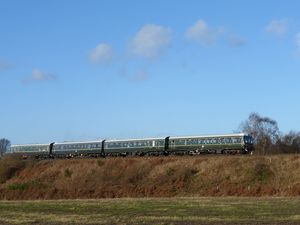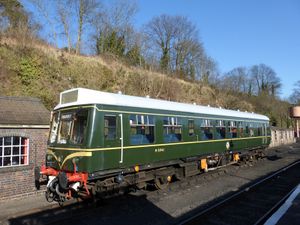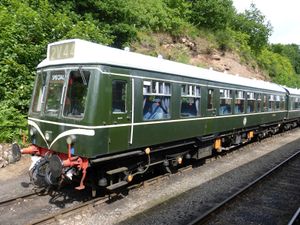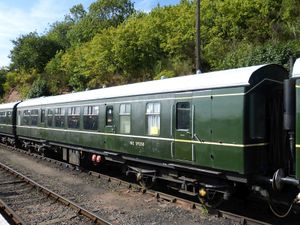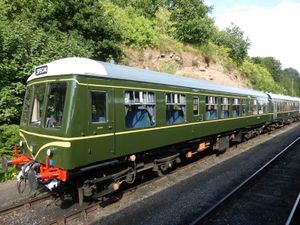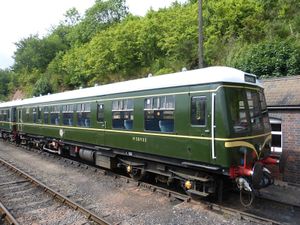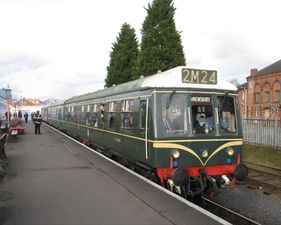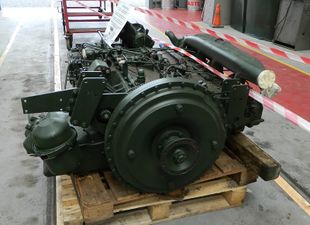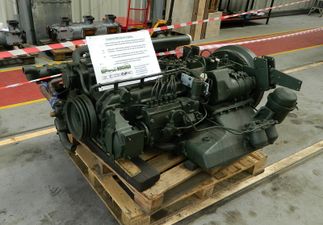Class 108 DMU
Contents
BR Class 108 General Information
The BR Class 108 diesel multiple units (DMU) were built by BR at Derby between 1958 and 1961. They are mainly of aluminium construction, with steel cab ends. Typically they were operated in 2, 3, or 4 car sets. A total of 333 cars were built, comprising[1]:
| Car type | Description | Number built | Seating capacity as built | SVR Examples |
|---|---|---|---|---|
| Driving Motor Brake Second (DMBS) | Powered driving car | 152 | 52 second class | M50933 (formerly M53933[2]), M51941, M51935 (scrapped) |
| Driving Motor Composite with lavatory (DMCL) | Powered driving car | 58 | 12 first 53 second | M52064 |
| Driving Trailer Composite with lavatory (DTCL) | Unpowered driving car | 106 | 12 first 53 second | E56208 |
| Trailer Second with lavatory (TSL) | Unpowered centre car | 11 | 68 second class | NE59250 |
| Trailer Brake Second with lavatory (TBSL) | Unpowered centre car | 6 | 50 second class |
Withdrawal of the class from service began in 1990. Unlike some other early models of DMU, the class 108 did not contain asbestos, making them suitable for preservation on heritage railways.
DMU Group vehicles
The DMU on the SVR is owned and operated by The DMU Group (West Midlands). The DMU Group operates five cars which can be used as separate three- and two-car units, although historically they have regularly been combined to form a five-car unit for purposes such as the summer Scenic Cruises. From time to time maintenance requirements have also resulted in operation as a four-car unit as pictured above.
The first two powered driving cars, DMBS 51941 and DMCL 52064 were both withdrawn from BR service in November 1990.[3] They were acquired by the embryonic DMU Group and both arrived on the SVR by rail from Doncaster via Tyseley on 30 March 1991, initially on a two-year loan. Having been re-liveried into original green livery, the two-car set was formally commissioned on 13 October 1991. After a return trip from Kidderminster to Bridgnorth, the MD of Regional Railways presented the key to officers of the DMU Group.[4]
Unpowered centre car TBSL 59250 was withdrawn from BR service in July 1991. It arrived on the SVR on 7 June 1992 and, after being repainted into green livery, it entered service that November to form a three-car unit.[3] The centre car includes the Group's main bar facility, called 'The Travelling Tavern', which was fitted in 2009. It was refitted in 2024.
A fourth car, DMBS 51935, was purchased in June 1992 as a source of spares, but by winter of 1996 had been restored and entered service.[3]
51941 visited Worcester open day in May 1993.[2]
The Group then acquired a fifth car, unpowered DTCL 56208, giving an additional 65 seats capacity. 56208 was withdrawn from BR service in March 1993 and was first preserved at the Caerphilly Railway Centre. Following the closure of the centre it was transferred to the SVR, arriving on 21 December 1996. The vehicle was repainted into BR green and entered service in July 1997. 56208 was normally operated as trailer car for 51935 in a two-car set, although it can run with either of the group's (DMBS) power cars.[3]
In 2004, all five cars took part in the Railcar50 event, participating in a 12-car special which was the longest DMU formation ever to operate in preservation.[2]
M51935 was extensively damaged by fire in April 2008 in what was believed to be an arson attack. The Group acquired DMBS 50933 as a replacement. 50933 had been preserved by a private individual in 1993 at Peak Rail and purchased by the Dean Forest DMU Group in 2008 when the Peak Rail fleet was disbanded. However it was effectively surplus to their requirements and arrived on the SVR, initially on loan. After 51935 was confirmed as beyond economic repair, 50933 was sold to the DMU Group, becoming a permanent resident. Following an extensive mechanical overhaul, 50933 entered regular service in July 2009. 51935 subsequently left the SVR to be broken for spares elsewhere.[3]
In 2010 alterations were made for the conveyance of wheelchair passengers.
In 2015 56208, 52064 and 59250 underwent contract bodywork and a repaint at Peak Rail. 52064's bogies were sent away during 2016 for tyre turning[2].
Maintenance issues from 2018
The DMU group has used Peak Rail and the SVR's Bewdley and Kidderminster workshops for contract overhauls, while undertaking maintenance itself at Bewdley. For much of 2018 and 2019 the DMU was unavailable for service for attention to various mechanical and electrical issues. It then being the only diesel-powered train capable of providing a heated train on the SVR, a mixture of steam and hired-in diesel locomotives deputised for the winter services and the summer Scenic Cruises.
By June 2019 all five vehicles were out of service due to considerable repairs needed on some of the bogies and brakegear, and the SVR mandating the units could not run. The DMUs had suffered from a lack of maintenance and paperwork had been an issue.[5] The repairs required the units to go to either the carriage repair works or diesel depot as the group lacked the resources and manpower to lift the vehicles.[6][7] In the event repairs fell initially to the carriage repair team on 52064, where it was held up by other work and COVID-19 restrictions.
Eventually, a two-car unit of 50933 and 52064 became available for traffic in November 2020, working Santa Staff trains.[8] However 50933 was not deemed suitable for any passenger services without further mechanical work and the fleet returned to store.[2]
In 2022 the owning group commissioned a third-party engineer to produce a report detailing repairs and maintenance work required in order to return the DMU to traffic on the SVR. Chief among the work necessary was overhaul of the bogies. The group determined that an external contractor would carry out further bogie overhauls, with the intention of initially returning 52064 and 51941 to traffic as a twin power car set.[9] As a result, 51941 was placed on accommodation bogies and its own sent for contract overhaul at the North Yorkshire Moors Railway workshops, while the car had repairs to the roof and remedial works to the rather tired paintwork at Kidderminster Carriage Shed.[10] The two-car set returned to traffic in December 2023.
In February 2024 centre car E59250 was also returned to traffic to make a three car DMU. This was stationed at Bridgnorth, rather than its normal base at Bewdley, to provide a daily service starting at the north end of the line during half term operations while work was in progress on the second phase of the Bridgnorth yard relay.
The DMU Group's other two cars require further work before they can re-enter service and the Group has launched a fundraising campaign to help with this. Details can be found on the Group's Restoration Fund page (external link).
Gallery
See also
References
- ↑ BR Class 108 on Wikipedia
- ↑ 2.0 2.1 2.2 2.3 2.4 preserved.railcar.co.uk
- ↑ 3.0 3.1 3.2 3.3 3.4 DMU Group 'Our Units'
- ↑ SVR News 102
- ↑ SVR Company Limited AGM minutes 16 July 2022
- ↑ DMU Blue Square blog, 5 June 2019 (Retrieved 9 November 2020)
- ↑ SVR News207
- ↑ SVR Diesels Official Facebook, 8 November 2020 (Retrieved 9 November 2020)
- ↑ Branch Lines October 2022
- ↑ The DMU Group (West Midlands) website (Retrieved 23 June 2023)
Links
| ||||||||||||||||||||||||||||||||||||||||||||||||||||||||||||||||||||||||
